According to the Florida Ornithological Society Records Committee (FOSRC) there are 536 bird species in Florida. 167 of those occur accidentally, 18 have been introduced, 4 are extinct, and 1 has been extirpated.
We went through the entire list to find white-colored ones but unfortunately, there aren’t too many of them that are tiny.
Examples of small white birds in Florida include the piping plover, sanderling, snowy plover, white rock pigeon, and Wilson’s plover.
Here’s what each of those looks like and how to identify them in nature.
Table of Contents
Small White Birds In Florida
1. Piping Plover
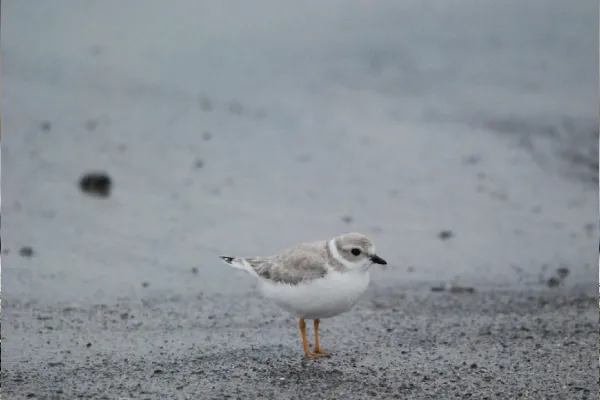
- Scientific Name: Charadrius melodus
- Wingspan: 14-16 in
- Length: 5.9-7.5 in
- Weight: 1.5–2.3 oz
Piping plovers are small shore birds, that measure about 6.5 inches long, weigh 1.9 ounces, and have a 15-inch-long wingspan.
These sparrow-sized birds have white underparts, white wing stripes visible in flight, sandy grayish-brown upperparts, orange legs, and black collars on their chests (during breeding season). Compared to other small plovers, they are notably paler.
The species is very vocal and will make sad-sounding whistles. They can be found on the Atlantic Coast of the USA and Canada and on the shores of the Great Lakes.
Piping Plover Call | Source: G. McGrane, Public domain, via Wikimedia Commons
Piping plovers do not breed in Florida but can be seen in the state during winter, along the Gulf of Mexico coastline and Florida’s Atlantic Coast. They inhabit sandy beaches, sand flats, and mudflats along coastal areas there.
Piping plovers breed from mid-April to early August – pairs that nest early have a greater chance of successfully raising their young than those nesting later in the season.
Their total population is estimated to be between 7,600 and 8,400 and the species is considered Near Threatened by the International Union for Conservation of Nature (IUCN).
2. Sanderling
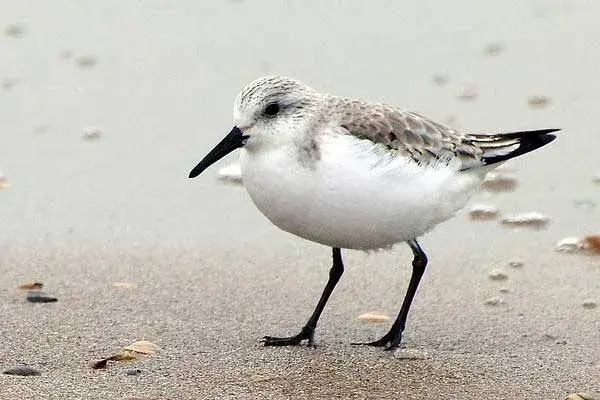
- Scientific Name: Calidris alba
- Wingspan: 17 in
- Length: 7.1–8.7 in
- Weight: 2.1 oz
Sanderlings are small waddling birds whose scientific name “alba” comes from Latin and means “white”. And this perfectly describes them as they are overall white with pale gray backs, and black beaks and legs.
They can weigh as little as 1.4 ounces which is less than 2 pennies!
Sanderlings are commonly found waddling in small groups in mudflats and along the shore, looking for small insects and shellfish.
After breeding in the High Arctic tundra, they migrate south around fall and become one of the most common birds. Sanderlings are one of the whitest small birds in Florida and can be seen on the state’s beaches in the Gulf of Mexico and on the Atlantic Coast.
They are mostly monogamous and become very aggressive and territorial during breeding time.
After spending summer in the Far North, some sanderlings return to Hawaii and spend winter there. These small white birds are also known as Hunakai there.
Read More: What are some other examples of white birds found in Hawaii?
3. White Rock Pigeon
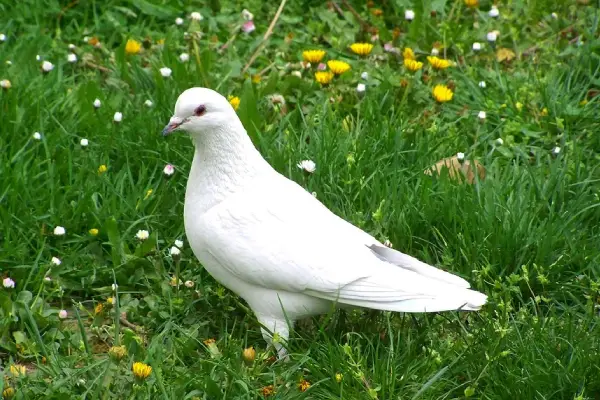
- Scientific Name: Columba livia
- Wingspan: 24-28 in
- Length: 11-15 in
- Weight: 8.4-13.4 oz
Rock pigeons are one of the most recognizable birds in Florida.
Also known as rock doves and common pigeons, these birds with small heads and short legs come in different colors – some individuals can be nearly all white!
These birds can be seen year-round in Florida, feeding on abandoned human food or visiting bird feeders.
People usually raise white domestic rock doves for their small size and white color – these birds are then used at events like weddings, funerals, and public ceremonies. Pigeons have an excellent orientation in nature and can easily find their way home – they navigate by sensing the earth’s magnetic fields.
Pigeons were introduced to North America from Europe in the early 17th century and had thrived ever since. Look for them in urban parks, farms, under bridges, and around tall rocky cliffs.
4. Snowy Plover
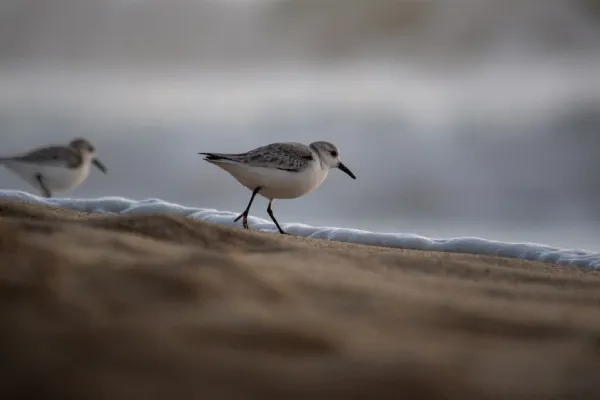
- Scientific Name: Charadrius nivosus
- Wingspan: 13.4 in
- Length: 6.5 in
- Weight: 1.1-2 oz
Snowy plovers are small whitish shorebirds that belong to the plover bird family.
They are around 6.5 inches long and weigh as little as 1.1 ounces! Snowy plovers are white underneath and very pale on top – during summer adults will develop black spots on their plumage.
Snowy plovers are permanent residents in Florida and breed on open sandy beaches along the Gulf Coast from February to August. They have two populations there: one in northwestern Florida, from Franklin County west, and the other in southwestern Florida, from Pasco to Collier counties.
These birds mostly feed on seeds, marine worms, clams, crabs, and sand hoppers and have a very interesting way of hunting – snowy plovers will run for a few steps, pause, and then run again before plucking at the ground for prey.
Snowy plovers are state-designated as Threatened in Florida and their population is decreasing due to habitat loss and predation.
5. Wilson’s Plover
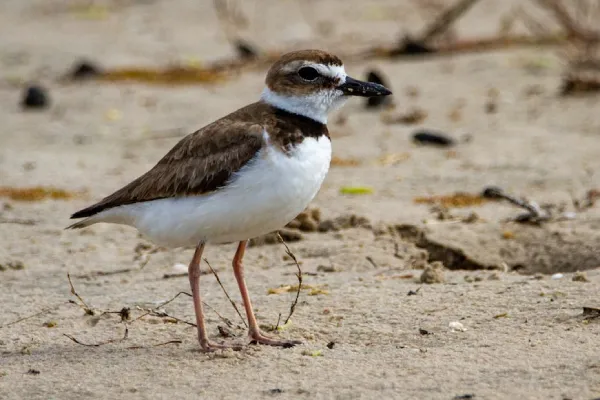
- Scientific Name: Charadrius wilsonia
- Wingspan: 19 in
- Length: 6.3-7.9 in
- Weight: 1.9-2.5 oz
Wilson’s plovers are small shorebirds that measure from 6.3 to 7.9 inches long and weigh as little as 1.9 ounces. They have white underparts, grayish-brown upperparts, and white stripes above their eyes.
Wilson’s plovers are common in coastal parts of Florida with winter populations found in the southern peninsula and breeding ones in the northern parts of the state.
These birds are mostly solitary but might occasionally form some smaller flocks. They were named by American zoologist Goerge Ord after his friend, Alexander Wilson, who is often referred to as “the father of American ornithology.”
Summary
Birds get their color from different pigments – white birds lack the color pigment called melanin. Some bird species are naturally white, while some other individual birds can have a genetic mutation that results in albinism.
Despite having impressive avifauna, there aren’t too many small white birds in Florida. Some examples include plovers, pigeons, and sandpipers.
If you enjoyed our article, feel free to read about the incredible pink birds found in Florida and also the largest birds found there.